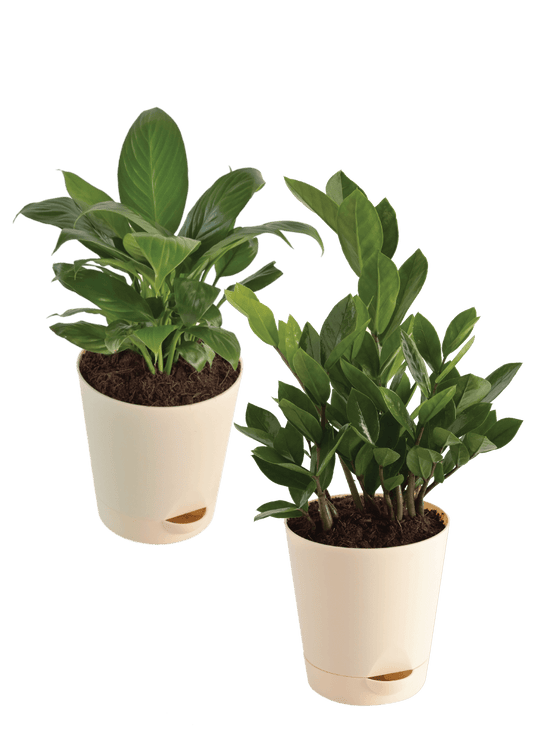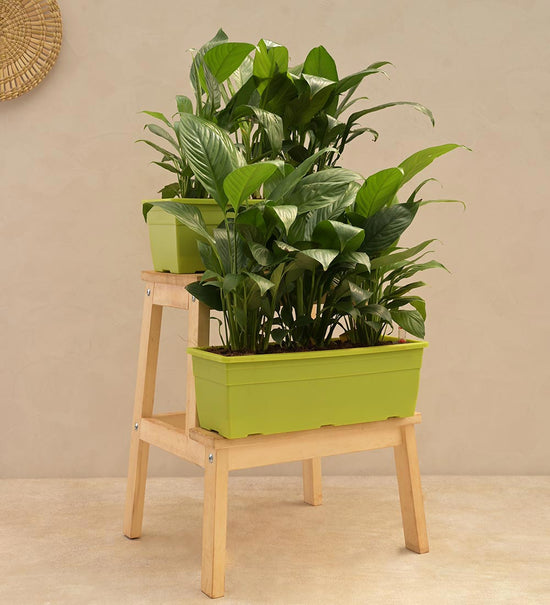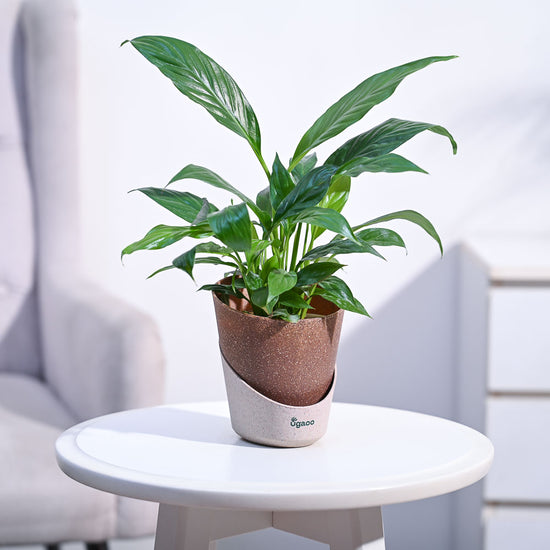▶Peace lily indoor
The Peace lily plants sport elegant arching leaves that emerge directly from the ground in a cluster form. As the weather starts getting warmer in spring, they start blooming with stunning white flowers.
Peace lily flowers are actually modified leaves of ‘bract’ and have no fragrance. However, these elegant white flowers on tall stems emerging from a sea of green foliage are a thing of beauty. The plant blooms profusely from spring to monsoon in India. These NASA-approved air purifiers remove a wide spectrum of indoor air pollutants to give you and your family a clean living space. With their ability to live happily in the shade and air-purifying quality, they make excellent
bedroom plants to help you sleep better. They are also an excellent choice of plant to keep on the window sills of your well-lit bathrooms.
▶Types of Peace Lily
There are several types and cultivars of peace lilies (Spathiphyllum species) that vary in size, leaf shape, and flower characteristics. While the most commonly found peace lily is the Spathiphyllum wallisii, there are other varieties that offer unique features. Here are some popular types of peace lilies:
✔Spathiphyllum wallisii:
Also known as the classic peace lily, it features glossy, dark green leaves with elegant white spathes (modified leaves) surrounding a creamy white spadix (flower spike).
✔Spathiphyllum mauna loa:
This variety is a larger version of the classic peace lily, featuring larger and broader leaves. The flowers are also larger and more prominent.
✔Spathiphyllum sensation:
This cultivar has broader and thicker leaves than the classic peace lily, and its flowers are notably larger and more elongated.
✔Spathiphyllum domino:
Characterized by its variegated foliage, the domino variety has dark green leaves with white or yellowish spots, adding a unique decorative touch to the plant.
✔Spathiphyllum cupido:
This cultivar has more compact growth, making it suitable for smaller indoor spaces. Its leaves are narrow and elongated, and the flowers are relatively smaller.
✔Spathiphyllum Picasso:
Named after the renowned artist, this variety features attractive green and white variegated leaves, adding an artistic flair to the plant.
✔Spathiphyllum petite:
As the name suggests, this is a dwarf peace lily variety, ideal for tiny pots and tight spaces. Its compact size makes it an excellent choice for small desks and shelves.
✔Spathiphyllum chopin:
This cultivar has distinctive ruffled white spathes, giving it a unique appearance compared to the typical peace lily.
✔Spathiphyllum joli:
Another compact variety, joli, has smaller leaves and flowers, making it suitable for small indoor spaces or as a tabletop centerpiece.
▶Benefits of Peace Lily Plant
◼Air Purification:
The peace lily
indoor plant is a powerful air purifier, effectively removing harmful pollutants like formaldehyde, benzene, and ammonia from the air. Its ability to detoxify indoor spaces makes it a valuable addition to homes and offices.
◼Aesthetic Appeal:
With its attractive dark green foliage and elegant white peace lily flowers, this plant adds a touch of beauty and sophistication to any indoor setting. Its graceful appearance enhances the overall aesthetics of the space.
◼Harmony and Balance:
In feng shui, the peace lily symbolizes harmony and balance. It is believed to attract positive energy and promote a harmonious environment in the home or office.
◼Long Blooming Period:
Peace lily flowers can bloom for several weeks, adding beauty and freshness to the indoor space for an extended period.
◼Stress Reduction:
Research has shown that having indoor plants like the peace lily can reduce stress, anxiety, and depression. The presence of greenery indoors creates a calming and soothing atmosphere.
▶Peace lily as a gift
Gifting a peace lily can be a thoughtful and meaningful gesture, as this beautiful houseplant carries various symbolic meanings and benefits. Here are some reasons why a peace lily makes a great gift:
➡Symbolism of Peace:
As the name suggests, the peace lily symbolizes peace, harmony, and tranquility. Gifting a peace lily conveys wishes for a peaceful and calm environment for the recipient.
➡Expression of Care and Love:
Giving a peace lily as a gift shows that you care about the recipient's well-being and happiness. It is a thoughtful way to express your love and affection.
➡Gifting for Various Occasions:
Peace lilies make suitable gifts for a wide range of occasions, such as
birthdays,
anniversaries,
housewarmings, graduations, or as a get-well present.
➡Eco-Friendly Gift:
Gifting a peace lily aligns with environmentally conscious choices, as it contributes to cleaner indoor air and a healthier environment.
 Air Purifying Plant Bundle - ZZ,...
Air Purifying Plant Bundle - ZZ,... Peace Lily Plant - Set of 2
Peace Lily Plant - Set of 2








